20th century in science
The development of post-Newtonian theories in physics, such as
A massive amount of new technologies were developed in the 20th century. Technologies such as
Astronomy and spaceflight

- A much better understanding of the evolution of the universe was achieved, its age (about 13.8 billion years) was determined, and the Big Bang theory on its origin was proposed and generally accepted.
- The age of the Solar System, including Earth, was determined, and it turned out to be much older than believed earlier: more than 4 billion years, rather than the 20 million years suggested by Lord Kelvin in 1862.[2]
- The planets of the Solar System and their moons were closely observed via numerous space probes. Pluto was discovered in 1930 on the edge of the solar system, although in the early 21st century, it was reclassified as a dwarf planet(planetoid) instead of a planet proper, leaving eight planets.
- No trace of Extrasolar planetswere observed for the first time.
- In 1969, Apollo 11 was launched towards the Moon and Neil Armstrong and Buzz Aldrin became the first persons from Earth to walk on another celestial body.
- That same year, Soviet astronomer Victor Safronov published his book Evolution of the protoplanetary cloud and formation of the Earth and the planets. In this book, almost all major problems of the planetary formation process were formulated and some of them solved. Safronov's ideas were further developed in the works of George Wetherill, who discovered runaway accretion.
- The Space Race between the United States and the Soviet Union gave a peaceful outlet to the political and military tensions of the Cold War, leading to the first human spaceflight with the Soviet Union's Vostok 1 mission in 1961, and man's first landing on another world—the Moon—with America's Apollo 11 mission in 1969. Later, the first space station was launched by the Soviet space program. The United States developed the first (and to date only) reusable spacecraft system with the Space Shuttle program, first launched in 1981. As the century ended, a permanent human presence in space was being founded with the ongoing construction of the International Space Station.
- In addition to human spaceflight, uncrewed space probes became a practical and relatively inexpensive form of exploration. The first orbiting space probe, Sputnik 1, was launched by the Soviet Union in 1957. Over time, a massive system of artificial satellites was placed into orbit around Earth. These satellites greatly advanced navigation, communications, military intelligence, geology, climate, and numerous other fields. Also, by the end of the 20th century, uncrewed probes had visited the Moon, Mercury, Venus, Mars, Jupiter, Saturn, Uranus, Neptune, and various asteroids and comets. The Hubble Space Telescope, launched in 1990, greatly expanded our understanding of the Universe and brought brilliant images to TV and computer screens around the world.
Biology and medicine
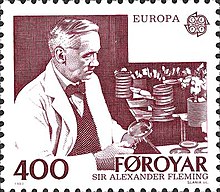
- James Watson,[3][4] Francis Crick,[3][4] Rosalind Franklin[4] and Maurice Wilkins,[3][4] following by developing techniques which allow to read DNA sequences and culminating in starting the Human Genome Project (not finished in the 20th century) and cloning the first mammalin 1996.
- The role of sexual reproduction in evolution was understood, and bacterial conjugation was discovered.
- The convergence of various sciences for the formulation of the modern evolutionary synthesis (produced between 1936 and 1947), providing a widely accepted account of evolution.
- blinded clinical trialsbecame a powerful tool for testing new medicines.
- bacterial diseases and their prevalence.
- A vaccine was developed for polio, ending a worldwide epidemic. Effective vaccines were also developed for a number of other serious infectious diseases, including influenza, diphtheria, pertussis (whooping cough), tetanus, measles, mumps, rubella (German measles), chickenpox, hepatitis A, and hepatitis B.
- Epidemiology and vaccination led to the eradication of the smallpox virus in humans.
- sonography and magnetic resonance imaging.
- Development of vitamins virtually eliminated scurvyand other vitamin-deficiency diseases from industrialized societies.
- New psychiatric drugs were developed. These include antipsychotics for treating hallucinations and delusions, and antidepressants for treating depression.
- The role of tobacco smoking in the causation of cancer and other diseases was proven during the 1950s (see British Doctors Study).
- New methods for cancer treatment, including chemotherapy, radiation therapy, and immunotherapy, were developed. As a result, cancer could often be cured or placed in remission.
- The development of blood typing and blood banking made blood transfusion safe and widely available.
- The organ and tissue transplantationa clinical reality.
- New methods for pacemakers and artificial hearts.
- drug dealing, and in some countries (e.g. the United States) to prison inmate sentences being 80% related to drug use by the 1990s.
- Contraceptive drugs were developed, which reduced population growth rates in industrialized countries, as well as decreased the taboo of premarital sexthroughout many western countries.
- The development of medical insulin during the 1920s helped raise the life expectancy of diabetics to three times of what it had been earlier.
- Vaccines, hygiene and clean water improved health and decreased mortality rates, especially among infants and the young.
Notable diseases
- An Spanish Flu, killed anywhere from 20 to 100 million people between 1918 and 1919.
- A new developing countries, and a cure has yet to be discovered.
- Because of increased life spans, the prevalence of cancer, Alzheimer's disease, Parkinson's disease, and other diseases of old age increased slightly.
- Sedentary lifestyles, due to labor-saving devices and technology, along with the increase in home entertainment and technology such as television, video games, and the internet contributed to an "epidemic" of obesity, at first in the rich countries, but by the end of the 20th century spreading to the developing world.
Chemistry
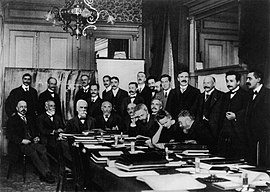
In 1903, Mikhail Tsvet invented chromatography, an important analytic technique. In 1904, Hantaro Nagaoka proposed an early nuclear model of the atom, where electrons orbit a dense massive nucleus. In 1905, Fritz Haber and Carl Bosch developed the Haber process for making ammonia, a milestone in industrial chemistry with deep consequences in agriculture. The Haber process, or Haber-Bosch process, combined nitrogen and hydrogen to form ammonia in industrial quantities for production of fertilizer and munitions. The food production for half the world's current population depends on this method for producing fertilizer. Haber, along with Max Born, proposed the Born–Haber cycle as a method for evaluating the lattice energy of an ionic solid. Haber has also been described as the "father of chemical warfare" for his work developing and deploying chlorine and other poisonous gases during World War I.
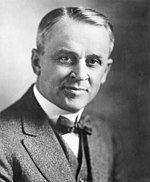
In 1905,
In 1909,
In 1913, Niels Bohr, a Danish physicist, introduced the concepts of quantum mechanics to atomic structure by proposing what is now known as the Bohr model of the atom, where electrons exist only in strictly defined circular orbits around the nucleus similar to rungs on a ladder. The Bohr Model is a planetary model in which the negatively charged electrons orbit a small, positively charged nucleus similar to the planets orbiting the Sun (except that the orbits are not planar) - the gravitational force of the solar system is mathematically akin to the attractive Coulomb (electrical) force between the positively charged nucleus and the negatively charged electrons.
In 1913, Henry Moseley, working from Van den Broek's earlier idea, introduces concept of atomic number to fix inadequacies of Mendeleev's periodic table, which had been based on atomic weight. The peak of Frederick Soddy's career in radiochemistry was in 1913 with his formulation of the concept of isotopes, which stated that certain elements exist in two or more forms which have different atomic weights but which are indistinguishable chemically. He is remembered for proving the existence of isotopes of certain radioactive elements, and is also credited, along with others, with the discovery of the element protactinium in 1917. In 1913, J. J. Thomson expanded on the work of Wien by showing that charged subatomic particles can be separated by their mass-to-charge ratio, a technique known as mass spectrometry.
In 1916,
The 1920s saw a rapid adoption and application of Lewis's model of the electron-pair bond in the fields of organic and coordination chemistry. In organic chemistry, this was primarily due to the efforts of the British chemists
Quantum chemistry
Some view the birth of quantum chemistry in the discovery of the
Still, skepticism remained as to the general power of quantum mechanics applied to complex chemical systems.[citation needed] The situation around 1930 is described by Paul Dirac:[6]
The underlying physical laws necessary for the mathematical theory of a large part of physics and the whole of chemistry are thus completely known, and the difficulty is only that the exact application of these laws leads to equations much too complicated to be soluble. It therefore becomes desirable that approximate practical methods of applying quantum mechanics should be developed, which can lead to an explanation of the main features of complex atomic systems without too much computation.
Hence the quantum mechanical methods developed in the 1930s and 1940s are often referred to as theoretical
In the 1940s many physicists turned from molecular or atomic physics to nuclear physics (like J. Robert Oppenheimer or Edward Teller). Glenn T. Seaborg was an American nuclear chemist best known for his work on isolating and identifying transuranium elements (those heavier than uranium). He shared the 1951 Nobel Prize for Chemistry with Edwin Mattison McMillan for their independent discoveries of transuranium elements. Seaborgium was named in his honour, making him one of three people, along Albert Einstein and Yuri Oganessian, for whom a chemical element was named during his lifetime.
Molecular biology and biochemistry
By the mid 20th century, in principle, the integration of physics and chemistry was extensive, with chemical properties explained as the result of the
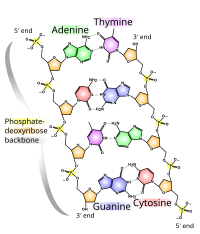
This heuristic approach triumphed in 1953 when
In the same year, the
In 1983
An important piece in the double helix puzzle was solved by one of Pauling's students
They used a centrifugation technique that sorted molecules according to differences in weight. Because nitrogen atoms are a component of DNA, they were labelled and therefore tracked in replication in bacteria.
Late 20th century

In 1970, John Pople developed the Gaussian program greatly easing computational chemistry calculations.[10] In 1971, Yves Chauvin offered an explanation of the reaction mechanism of olefin metathesis reactions.[11] In 1975, Karl Barry Sharpless and his group discovered a stereoselective oxidation reactions including Sharpless epoxidation,[12][13] Sharpless asymmetric dihydroxylation,[14][15][16] and Sharpless oxyamination.[17][18][19] In 1985,
Earth science
In 1912
Unfortunately, Wegener provided no convincing mechanism for this drift, and his ideas were not generally accepted during his lifetime. Arthur Homes accepted Wegener's theory and provided a mechanism: mantle convection, to cause the continents to move.[27] However, it was not until after the Second World War that new evidence started to accumulate that supported continental drift. There followed a period of 20 extremely exciting years where the Theory of Continental Drift developed from being believed by a few to being the cornerstone of modern Geology. Beginning in 1947 research found new evidence about the ocean floor, and in 1960 Bruce C. Heezen published the concept of mid-ocean ridges. Soon after this, Robert S. Dietz and Harry H. Hess proposed that the oceanic crust forms as the seafloor spreads apart along mid-ocean ridges in seafloor spreading.[28] This was seen as confirmation of mantle convection and so the major stumbling block to the theory was removed. Geophysical evidence suggested lateral motion of continents and that oceanic crust is younger than continental crust. This geophysical evidence also spurred the hypothesis of paleomagnetism, the record of the orientation of the Earth's magnetic field recorded in magnetic minerals. British geophysicist S. K. Runcorn suggested the concept of paleomagnetism from his finding that the continents had moved relative to the Earth's magnetic poles. Tuzo Wilson, who was a promoter of the sea floor spreading hypothesis and continental drift from the very beginning,[29] added the concept of transform faults to the model, completing the classes of fault types necessary to make the mobility of the plates on the globe function.[30] A symposium on continental drift[31] was held at the Royal Society of London in 1965 must be regarded as the official start of the acceptance of plate tectonics by the scientific community. The abstracts from the symposium are issued as Blacket, Bullard, Runcorn;1965.In this symposium, Edward Bullard and co-workers showed with a computer calculation how the continents along both sides of the Atlantic would best fit to close the ocean, which became known as the famous "Bullard's Fit". By the late 1960s the weight of the evidence available saw Continental Drift as the generally accepted theory.
Other theories of the causes of climate change fared no better. The principal advances were in observational
Through the 1930s the most persistent advocate of a solar-climate connection was astrophysicist
Meanwhile
In 1938
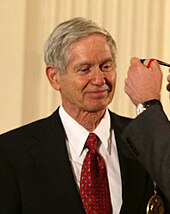
Another clue to the nature of climate change came in the mid-1960s from analysis of deep-sea cores by
Scientists meanwhile began using computers to develop more sophisticated versions of Arrhenius's calculations. In 1967, taking advantage of the ability of digital computers to integrate absorption curves numerically,
They found that, in the absence of unknown feedbacks such as changes in clouds, a doubling of carbon dioxide from the current level would result in approximately 2 °C increase in global temperature.By the 1960s,
A 1968 study by the
If the earth's temperature increases significantly, a number of events might be expected to occur, including the melting of the Antarctic ice cap, a rise in sea levels, warming of the oceans, and an increase in photosynthesis. [..] Revelle makes the point that man is now engaged in a vast geophysical experiment with his environment, the earth. Significant temperature changes are almost certain to occur by the year 2000 and these could bring about climatic changes.
In 1969, NATO was the first candidate to deal with climate change on an international level. It was planned then to establish a hub of research and initiatives of the organization in the civil area, dealing with environmental topics[41] as acid rain and the greenhouse effect. The suggestion of US President Richard Nixon was not very successful with the administration of German Chancellor Kurt Georg Kiesinger. But the topics and the preparation work done on the NATO proposal by the German authorities gained international momentum, (see e.g. the Stockholm United Nations Conference on the Human Environment 1970) as the government of Willy Brandt started to apply them on the civil sphere instead.[41][clarification needed]
Also in 1969,
In the early 1970s, evidence that aerosols were increasing worldwide encouraged Reid Bryson and some others to warn of the possibility of severe cooling. Meanwhile, the new evidence that the timing of ice ages was set by predictable orbital cycles suggested that the climate would gradually cool, over thousands of years. For the century ahead, however, a survey of the scientific literature from 1965 to 1979 found 7 articles predicting cooling and 44 predicting warming (many other articles on climate made no prediction); the warming articles were cited much more often in subsequent scientific literature.[45] Several scientific panels from this time period concluded that more research was needed to determine whether warming or cooling was likely, indicating that the trend in the scientific literature had not yet become a consensus.[46][47][48]
John Sawyer published the study Man-made Carbon Dioxide and the “Greenhouse” Effect in 1972.[49] He summarized the knowledge of the science at the time, the anthropogenic attribution of the carbon dioxide greenhouse gas, distribution and exponential rise, findings which still hold today. Additionally he accurately predicted the rate of global warming for the period between 1972 and 2000.[50][51]
The increase of 25% CO2 expected by the end of the century therefore corresponds to an increase of 0.6°C in the world temperature – an amount somewhat greater than the climatic variation of recent centuries. – John Sawyer, 1972
The mainstream news media at the time exaggerated the warnings of the minority who expected imminent cooling. For example, in 1975, Newsweek magazine published a story that warned of "ominous signs that the Earth's weather patterns have begun to change."[52] The article continued by stating that evidence of global cooling was so strong that meteorologists were having "a hard time keeping up with it."[52] On 23 October 2006, Newsweek issued an update stating that it had been "spectacularly wrong about the near-term future".[53]
In the first two "Reports for the Club of Rome" in 1972[54] and 1974,[55] the anthropogenic climate changes by CO2 increase as well as by waste heat were mentioned. About the latter John Holdren wrote in a study[56] cited in the 1st report, “… that global thermal pollution is hardly our most immediate environmental threat. It could prove to be the most inexorable, however, if we are fortunate enough to evade all the rest.” Simple global-scale estimates[57] that recently have been actualized[58] and confirmed by more refined model calculations[59][60] show noticeable contributions from waste heat to global warming after the year 2100, if its growth rates are not strongly reduced (below the averaged 2% p.a. which occurred since 1973).
Evidence for warming accumulated. By 1975, Manabe and Wetherald had developed a three-dimensional
The 1979 World Climate Conference (12 to 23 February) of the World Meteorological Organization concluded "it appears plausible that an increased amount of carbon dioxide in the atmosphere can contribute to a gradual warming of the lower atmosphere, especially at higher latitudes....It is possible that some effects on a regional and global scale may be detectable before the end of this century and become significant before the middle of the next century."[62]
In July 1979 the
When it is assumed that the CO2 content of the atmosphere is doubled and statistical thermal equilibrium is achieved, the more realistic of the modeling efforts predict a global surface warming of between 2°C and 3.5°C, with greater increases at high latitudes. … we have tried but have been unable to find any overlooked or underestimated physical effects that could reduce the currently estimated global warmings due to a doubling of atmospheric CO2 to negligible proportions or reverse them altogether.
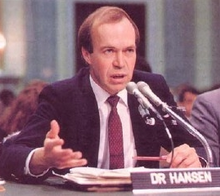
By the early 1980s, the slight cooling trend from 1945 to 1975 had stopped. Aerosol pollution had decreased in many areas due to environmental legislation and changes in fuel use, and it became clear that the cooling effect from aerosols was not going to increase substantially while carbon dioxide levels were progressively increasing.
Hansen and others published the 1981 study Climate impact of increasing atmospheric carbon dioxide, and noted:
It is shown that the anthropogenic carbon dioxide warming should emerge from the noise level of natural climate variability by the end of the century, and there is a high probability of warming in the 1980s. Potential effects on climate in the 21st century include the creation of drought-prone regions in North America and central Asia as part of a shifting of climatic zones, erosion of the West Antarctic ice sheet with a consequent worldwide rise in sea level, and opening of the fabled Northwest Passage.[64]
In 1982, Greenland ice cores drilled by Hans Oeschger, Willi Dansgaard, and collaborators revealed dramatic temperature oscillations in the space of a century in the distant past.[65] The most prominent of the changes in their record corresponded to the violent Younger Dryas climate oscillation seen in shifts in types of pollen in lake beds all over Europe. Evidently drastic climate changes were possible within a human lifetime.
In 1985 a joint UNEP/WMO/ICSU Conference on the "Assessment of the Role of Carbon Dioxide and Other Greenhouse Gases in Climate Variations and Associated Impacts" concluded that greenhouse gases "are expected" to cause significant warming in the next century and that some warming is inevitable.[66]
Meanwhile, ice cores drilled by a Franco-Soviet team at the Vostok Station in Antarctica showed that CO2 and temperature had gone up and down together in wide swings through past ice ages. This confirmed the CO2-temperature relationship in a manner entirely independent of computer climate models, strongly reinforcing the emerging scientific consensus. The findings also pointed to powerful biological and geochemical feedbacks.[67]
In June 1988,
The 1980s saw important breakthroughs with regard to global environmental challenges. Ozone depletion was mitigated by the Vienna Convention (1985) and the Montreal Protocol (1987). Acid rain was mainly regulated on national and regional levels.
Colors indicate temperature anomalies (
Since the 1990s, research on climate change has expanded and grown, linking many fields such as atmospheric sciences, numerical modeling, behavioral sciences, geology and economics, or security.
Engineering and technology
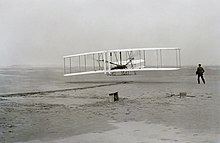
One of the prominent traits of the 20th century was the dramatic growth of technology. Organized research and practice of science led to advancement in the fields of communication, engineering, travel, medicine, and war.
- The number and types of record players These were in turn replaced by the CD during the late 1980s and 1990s. The proliferation of the Internet in the mid-to-late 1990s made digital distribution of music (mp3s) possible. VCRswere popularized in the 1970s, but by the end of the 20th century, DVD players were beginning to replace them, making the VHS obsolete by the end of the first decade of the 21st century.
- The first airplane was flown in 1903. With the engineering of the faster jet engine in the 1940s, mass air travel became commercially viable.
- The divided highwaysreduced the death rate.
- The triode tube, transistor and integrated circuit successively revolutionized electronics and computers, leading to the proliferation of the personal computer in the 1980s and cell phones and the public-use Internet in the 1990s.
- New materials, most notably stainless steel, Velcro, silicone, teflon, and plastics such as polystyrene, PVC, polyethylene, and nylon came into widespread use for many various applications. These materials typically have tremendous performance gains in strength, temperature, chemical resistance, or mechanical properties over those known prior to the 20th century.
- Aluminium became an inexpensive metal and became second only to iron in use.
- Semiconductor materials were discovered, and methods of production and purification developed for use in electronic devices. Silicon became one of the purest substances ever produced.
- Thousands of chemicalswere developed for industrial processing and home use.
Mathematics
The 20th century saw mathematics become a major profession. As in most areas of study, the explosion of knowledge in the scientific age has led to specialization: by the end of the century there were hundreds of specialized areas in mathematics and the
In a 1900 speech to the International Congress of Mathematicians, David Hilbert set out a list of 23 unsolved problems in mathematics. These problems, spanning many areas of mathematics, formed a central focus for much of 20th-century mathematics. Today, 10 have been solved, 7 are partially solved, and 2 are still open. The remaining 4 are too loosely formulated to be stated as solved or not.
In 1929 and 1930, it was proved the truth or falsity of all statements formulated about the
In 1963,

The development and continual improvement of
Physics
- New areas of physics, like special relativity, general relativity, and quantum mechanics, were developed during the first half of the century. In the process, the internal structure of atoms came to be clearly understood, followed by the discovery of elementary particles.
- It was found that all the known forces can be traced to only four fundamental interactions. It was discovered further that two forces, electromagnetism and weak interaction, can be merged in the electroweak interaction, leaving only three different fundamental interactions.
- Discovery of nuclear reactions, in particular nuclear fusion, finally revealed the source of solar energy.
- Radiocarbon dating was invented, and became a powerful technique for determining the age of prehistoric animals and plants as well as historical objects.
- chemical elements were created by nuclear fusionreactions within stars.
Quantum mechanics
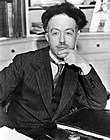  | |
 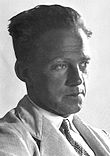 | |
| From left to right, top row: Louis de Broglie (1892–1987) and Wolfgang Pauli (1900–58); second row: Erwin Schrödinger (1887–1961) and Werner Heisenberg (1901–76) |
In 1924, French quantum physicist Louis de Broglie published his thesis, in which he introduced a revolutionary theory of electron waves based on wave–particle duality. In his time, the wave and particle interpretations of light and matter were seen as being at odds with one another, but de Broglie suggested that these seemingly different characteristics were instead the same behavior observed from different perspectives — that particles can behave like waves, and waves (radiation) can behave like particles. Broglie's proposal offered an explanation of the restricted motion of electrons within the atom. The first publications of Broglie's idea of "matter waves" had drawn little attention from other physicists, but a copy of his doctoral thesis chanced to reach Einstein, whose response was enthusiastic. Einstein stressed the importance of Broglie's work both explicitly and by building further on it.
In 1925, Austrian-born physicist
In 1926 at the age of 39, Austrian theoretical physicist Erwin Schrödinger produced the papers that gave the foundations of quantum wave mechanics. In those papers he described his partial differential equation that is the basic equation of quantum mechanics and bears the same relation to the mechanics of the atom as Newton's equations of motion bear to planetary astronomy. Adopting a proposal made by Louis de Broglie in 1924 that particles of matter have a dual nature and in some situations act like waves, Schrödinger introduced a theory describing the behaviour of such a system by a wave equation that is now known as the Schrödinger equation. The solutions to Schrödinger's equation, unlike the solutions to Newton's equations, are wave functions that can only be related to the probable occurrence of physical events. The readily visualized sequence of events of the planetary orbits of Newton is, in quantum mechanics, replaced by the more abstract notion of probability. (This aspect of the quantum theory made Schrödinger and several other physicists profoundly unhappy, and he devoted much of his later life to formulating philosophical objections to the generally accepted interpretation of the theory that he had done so much to create.)
German theoretical physicistSocial sciences
- Ivan Pavlov developed the theory of classical conditioning.
- The economic theorygained in prominence.
References
- ISBN 978-0-7456-3469-2.
- ^ Thomson, Sir William (1862). "On the Age of the Sun's Heat". Macmillan's Magazine. 5: 288–293.
- ^ a b c "The Nobel Prize in Physiology or Medicine 1962". NobelPrize.org. Nobel Media AB. Retrieved November 5, 2011.
- ^ a b c d "James Watson, Francis Crick, Maurice Wilkins, and Rosalind Franklin". Science History Institute. June 2016. Archived from the original on 21 March 2018. Retrieved 20 March 2018.
- ^ W. Heitler and F. London, Wechselwirkung neutraler Atome und Homöopolare Bindung nach der Quantenmechanik, Z. Physik, 44, 455 (1927).
- ^ P.A.M. Dirac, Quantum Mechanics of Many-Electron Systems, Proc. R. Soc. London, A 123, 714 (1929).
- ^ C.C.J. Roothaan, A Study of Two-Center Integrals Useful in Calculations on Molecular Structure, J. Chem. Phys., 19, 1445 (1951).
- ^ Watson, J. and Crick, F., "Molecular Structure of Nucleic Acids" Nature, April 25, 1953, p 737–8
- ^ The Miller Urey Experiment – Windows to the Universe
- ^ W. J. Hehre, W. A. Lathan, R. Ditchfield, M. D. Newton, and J. A. Pople, Gaussian 70 (Quantum Chemistry Program Exchange, Program No. 237, 1970).
- )
- Org. Synth., Coll. Vol. 7, p.461 (1990); Vol. 63, p.66 (1985). (Article)
- )
- )
- Org. Synth., Coll. Vol. 10, p.603 (2004); Vol. 79, p.93 (2002). (Article Archived 2010-08-24 at the Wayback Machine)
- )
- )
- Org. Synth., Coll. Vol. 7, p.375 (1990); Vol. 61, p.85 (1983). (Article Archived 2012-10-20 at the Wayback Machine)
- ^ "The Nobel Prize in Chemistry 1996". Nobelprize.org. The Nobel Foundation. Retrieved 2007-02-28.
- ^ "Benjamin Franklin Medal awarded to Dr. Sumio Iijima, Director of the Research Center for Advanced Carbon Materials, AIST". National Institute of Advanced Industrial Science and Technology. 2002. Archived from the original on 2007-04-04. Retrieved 2007-03-27.
- J. Am. Chem. Soc.; 1994; 116(4); 1597–1598. DOI Abstract
- J. Am. Chem. Soc.; 1994; 116(4) pp 1599–1600 DOI Abstract
- J. Am. Chem. Soc.; 1988; 110(19); 6558–6560. Abstract
- ^ "Cornell and Wieman Share 2001 Nobel Prize in Physics". NIST News Release. National Institute of Standards and Technology. 2001. Archived from the original on 2007-06-10. Retrieved 2007-03-27.
- ^ Wegener, Alfred (1912). "Die Herausbildung der Grossformen der Erdrinde (Kontinente und Ozeane), auf geophysikalischer Grundlage" (PDF)". Petermanns Geographische Mitteilungen. 63: 185–95, 253–56, 305–09.
- S2CID 122872384.
- ^ Hess, H. H. (1 November 1962). "History of Ocean Basins" (PDF). In A. E. J. Engel; Harold L. James; B. F. Leonard (eds.). Petrologic studies: a volume in honor of A. F. Buddington. Boulder, CO: Geological Society of America. pp. 599–620.
- S2CID 4209203.
- S2CID 4294401.
- ^ Blacket, P.M.S.; Bullard, E.; Runcorn, S.K., eds. (1965). "A Symposium on Continental Drift, held on 28 October 1965". Philosophical Transactions of the Royal Society A. 258 (1088). Royal Society of London.
- ^ a b Spencer Weart (2011). "Changing Sun, Changing Climate". The Discovery of Global Warming.
- ^ a b Hufbauer, K. (1991). Exploring the Sun: Solar Science since Galileo. Baltimore, MD: Johns Hopkins University Press.
- ISBN 1-901470-02-4.
- ^ a b Spencer Weart (2011). "Past Climate Cycles: Ice Age Speculations". The Discovery of Global Warming.
- ISBN 978-1878220769.
- ^ Spencer Weart (2011). "General Circulation Models of Climate". The Discovery of Global Warming.
- .
- ^ Ehrlich, Paul R. (1968). The Population Bomb. San Francisco: Sierra Club. p. 52.
- ^ E. Robinson; R.C. Robbins (1968). "Smoke & Fumes, Sources, Abundance & Fate of Atmospheric Pollutants". Stanford Research Institute.
- ^ ISBN 3-515-08188-7
- ^ "Ice in Action: Sea ice at the North Pole has something to say about climate change". YaleScientific. 2016.
- .
- doi:10.1002/wcc.412.
- S2CID 123635044.
- ^ Science and the Challenges Ahead. Report of the National Science Board. Washington, D.C. : National Science Board, National Science Foundation. 1974.
- ^ W M Connolley. "The 1975 US National Academy of Sciences/National Research Council Report". Retrieved 28 June 2009.
- ^ Reid A. Bryson:A Reconciliation of several Theories of Climate Change, in: John P. Holdren (Ed.): Global Ecology. Readings toward a Rational Strategy for Man, New York etc. 1971, S. 78–84
- S2CID 4180899.
- PMID 17728736.
- ISBN 9781440832024.
- ^ a b Peter Gwynne (1975). "The Cooling World" (PDF). Archived from the original (PDF) on 2013-04-20. Retrieved 2020-06-17.
- ^ Jerry Adler (23 October 2006). "Climate Change: Prediction Perils". Newsweek.
- ^ Meadows, D., et al., The Limits to Growth. New York 1972.
- ^ Mesarovic, M., Pestel, E., Mankind at the Turning Point. New York 1974.
- ^ John P. Holdren: "Global Thermal Pollution", in: John P. Holdren (Ed.): Global Ecology. Readings toward a Rational Strategy for Man, New York etc. 1971, S. 85–88. The author became Director of the White House Office of Science and Technology Policy in 2009.
- .
- ISBN 978-3-86360 063-1 online
- .
- .
- .
- ^ "Declaration of the World Climate Conference" (PDF). World Meteorological Organization. Retrieved 28 June 2009.
- ^
National Research Council (1979). Carbon Dioxide and Climate:A Scientific Assessment. Washington, D.C.: The National Academies Press. ISBN 978-0-309-11910-8.
- S2CID 20971423.
- S2CID 35224174.
- ^ World Meteorological Organisation (WMO) (1986). "Report of the International Conference on the assessment of the role of carbon dioxide and of other greenhouse gases in climate variations and associated impacts". Villach, Austria. Archived from the original on 21 November 2013. Retrieved 28 June 2009.
- S2CID 4368173.
- ^ "Statement of Dr. James Hansen, Director, NASA Goddard Institute for Space Studies" (PDF). The Guardian. London. Retrieved 28 June 2009.
- ^ WMO (World Meteorological Organization) (1989). The Changing Atmosphere: Implications for Global Security, Toronto, Canada, 27–30 June 1988: Conference Proceedings (PDF). Geneva: Secretariat of the World Meteorological Organization. Archived from the original (PDF) on 2012-06-29.
- ^ Brown, Dwayne; Cabbage, Michael; McCarthy, Leslie; Norton, Karen (20 January 2016). "NASA, NOAA Analyses Reveal Record-Shattering Global Warm Temperatures in 2015". NASA. Retrieved 21 January 2016.
- ^ "IPCC - Intergovernmental Panel on Climate Change". ipcc.ch.
- ^ Mathematics Subject Classification 2000

